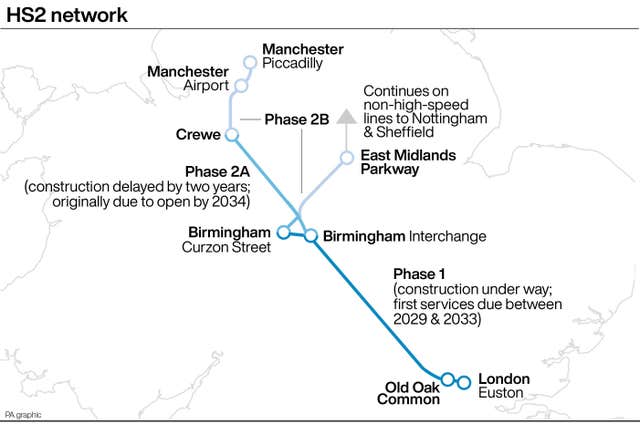The Prime Minister is reportedly considering axing plans for the HS2 high-speed rail link to run from Birmingham to Manchester amid soaring costs.
Critics of such a move include former prime ministers Boris Johnson and David Cameron, some business leaders and the Labour mayors of Greater Manchester and London, Andy Burnham and Sadiq Khan.
But Chancellor Jeremy Hunt has suggested the scheme is “out of control” and former transport secretary Grant Shapps said the Government could not write an “open-ended cheque” if costs continue to rise.

A decision on the fate of the project’s Manchester leg is expected in the coming days.
Here, the PA news agency explains what HS2 is, looks at the costs involved and how plans have changed.
– What is HS2?
A project for a high-speed rail line linking some of the country’s largest cities, intended to connect London, the Midlands and the north of England, with construction split into three phases.
HS2 puts direct intercity services onto dedicated high speed lines, freeing up space for commuter train services to run on the country’s most heavily congested rail routes. Find out more: https://t.co/Llv4VLhSyv pic.twitter.com/whhaqrzs2i
— HS2 Ltd (@HS2ltd) September 23, 2023
Gordon Brown’s Labour government set up HS2 Ltd in 2009 and the project has been backed by successive Conservative governments since 2010.
In 2020, then premier Mr Johnson recommitted his Government to the scheme following a review.
– What is the budget?
In 2013, HS2 was estimated to cost £37.5 billion in 2009 prices but the sums have continued to spiral.
A budget of £55.7 billion for the whole of HS2 was set in 2015 but some reports suggest costs have now surpassed £100 billion, having been driven up by recent inflation rises.
The target cost excluding the eastern leg of Phase 2b from the West Midlands to the East Midlands has soared to between £53 billion and £61 billion (at 2019 prices).
– How much has been spent so far?
As of June, the total was £24.7 billion (at 2019 prices).
– Why was it created?
Many supporters of HS2 say the main benefit will be increased capacity.
It will enable intercity trains currently operated by Avanti West Coast to be taken off the West Coast Main Line, creating more space for stopping services and freight trains.
Another improvement will be reduced journey times.
– What were the original plans?
Phase 1: London Euston to Birmingham Curzon Street, with intermediate stations at Old Oak Common in the western suburbs and at Birmingham Airport.

Phase 2a: To extend the line from Fradley in the West Midlands to Crewe in Cheshire.
Phase 2b: Comprised of an eastern leg from the West Midlands to the East Midlands and a western leg from Crewe to Manchester.
– How have the ambitions shrunk?
Ministers have already moved to pause parts of the project and even axed sections in the north.
The eastern leg between Birmingham and Leeds was reduced to a spur line that is due to end in the East Midlands.
It was confirmed in March that construction between Birmingham and Crewe would be delayed by two years and that services may not enter central London until the 2040s.

Transport Secretary Mark Harper announced that work at Euston would be paused for two years as costs were forecast to almost double to £4.8 billion.
The pause means Old Oak Common, in the capital’s western suburbs, will be the railway’s only London station when services to and from Birmingham Curzon Street begin between 2029 and 2033.
The Prime Minister is reportedly now considering scrapping the route from Birmingham to Manchester, with a decision on the fate of the leg north from Birmingham is expected within days.




Comments: Our rules
We want our comments to be a lively and valuable part of our community - a place where readers can debate and engage with the most important local issues. The ability to comment on our stories is a privilege, not a right, however, and that privilege may be withdrawn if it is abused or misused.
Please report any comments that break our rules.
Read the rules here